Savoie Fare: Distinctive and Immediately Appealing Wines From The French Alpine Region Rare Local Varieties + Domaine Blard & Fils (5-Bottle Sampler Pack $173)
Italy is one giant vineyard, cuff to heel, but in France, wine regions are like fireflies in a midnight garden; they light up isolated corners. The brightest fireflies command most of the attention, of course, and as a result, the highest price points. But Savoie—in the far eastern part of France where the Alps spill over from Italy and Switzerland—is one of most remarkable of the glimmers.
The White Stuff: A Golden Opportunity
According to Wink Lorch, an avid skier and arguably Savoie’s most vocal champion, the development of the post-war ski industry represented a turning point for the region’s popularity: “This created new customers for its wines, of which very little get exported. Even so, up until the 1970s, there were hardly any vine-growers who lived solely from their vines.”
Reconquering the Slopes
Over the past twenty years, however, a new wave of independent vignerons has been boosted by organizations dedicated to preserving the singular grape varieties of the region, and Savoie has finally begun to come into its own.
Alpine wines have a crunchy sizzle and a cool sappiness unlike wine from anywhere else. Not only that, but the predominant grapes don’t show up on many other radars, so the unique textures commingle with a whole new flavor profile to surprise and delight the palate.
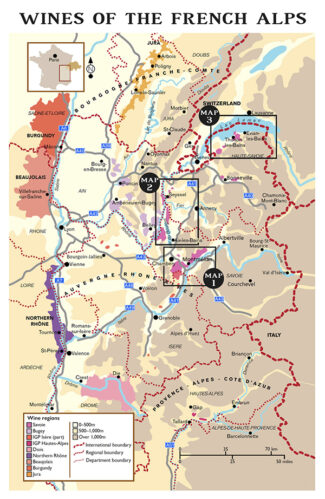
For the historically inclined, Savoie was the point where Hannibal crossed the Alps en route to Rome; for vinophiles, Savoie encompasses two main sub-appellations—Bugey, with 1250 acres of vines and Vin de Savoie, or simply Savoie AOP, which includes Roussette de Savoie and Roussette du Bugey. There are also 17 Vin de Savoies Crus and four Roussette de Savoie Crus, whose name may appear on labels. Most Savoie vineyards are planted on steep, south facing slopes, where favorable sunlight exposure and excellent drainage make for perfect ripening conditions despite the cold continental climate. The presence of lakes Bourget and Geneva, as well as the upper Rhône River, further moderate the climate. Most Vin de Savoie vineyards are found on limestone-based soils, which is adept at storing heat during the day and reflecting it back onto the vines at night.
Wines That Refresh Like Mountain Air
Metaphors linking wine to its place of origin are the stuff of poetry, but they’re also the foundation of terroir. Among the most common descriptors of high-altitude wine is ‘refreshing’ which is an offhand way of saying that they tend to be lower in alcohol and higher in acidity than valley wines. These acids are often the end result of the cool mountain air which they resemble, giving distinct, cleansing mineral characteristics to the wine with citrus and herbs rather than jammy fruit.
Managing Mountain Acidity While Keeping It Light
That said, it is sometimes a challenge for winemakers to reign in mountain-borne acid and to keep it from running away with the profile. Tart is acceptable—sour is not. Without delving into too much chemistry, the predominant acids found in wines are tartaric, malic, citric and succinic, and all but the last occur naturally in grapes—succinic acid is produced by yeast during fermentation. In areas where long hang-times for grape bunches to develop sugars and tame acidity are not possible in the mountains, and winemakers will occasionally resort to artificially manipulating the juice, the must, or as a last resort, the finished wine.
These are not wines we embrace at Elie’s, preferring those that display natural balance, favoring the expression of terroir over excessively extracted fruit with high sugar levels. Adjusting acid rather than preserving it defies one of winemaking’s oldest adages: ‘Good wine is made in the vineyard, not in the cellar.’
The wines of Savoie (even the reds) tend be light and somewhat playful on the palate, filled with alacrity and crackle and with correspondingly low alcohol levels to match an ethereal mountain finesse. Yet, we have found many wines of Blard & Fils that seek to take traditional Savoie varietals to the next level, busting through the clichéd ‘Ski & Raclette’ ceiling to create sophisticated wines suitable for the most refined tables.
Sampler Pack $173
The wines in this 5-Bottle Sampler Pack represent one of Savoie’s icons and iconoclasts, Thomas Blard, who has taken the management reins from his father Jean-Noël. They represent the wide array of native grapes and their associated flavor profiles that are typical of this hinterland of marvels.
‘The Rest’ covers wines from the dynamic husband and wife team of Florian and Marie Curtet, whose marriage is a match made in the vineyard—specifically, 12.3 acres of the most immaculate organic vineyards in the area. Through them, we showcase even more unique blends and varietals of Savoie.
Setting the (Appellation AOP) Scene: Savoie & Roussette de Savoie
Located in the foothills of the vast Alpine ranges of Switzerland and Italy, Savoie AOP grows grapes at altitudes between 800 and 1800 feet. Savoie’s 11,300 acres of scattered vineyards are responsible for less than 0.5% of the wine produced in France, and of the 3 millions of wine made in Savoie every year (compare this to Bordeaux’s 158 million), only about 8% of it is consumed outside the appellation. Although even the highest vineyards are at foothill-elevation, the region is distinctly alpine, with towering white-capped mountains and pristine lakes dominating the surrounding terrain: Mont Blanc, France’s tallest peak at 15,000 feet, has a Savoie zip code. The vineyards are adapted to this environment, growing occasionally on 80-degree slopes. Ranging from rocky subsoil to sand (sometimes in the same vineyard) the Savoie terroir supports 23 different grape varieties.
A large portion of western Savoie falls under the sub-appellation Roussette de Savoie. Encompassing four Cru communes—Frangy, Marestel, Monterminod and Monthoux—Roussette wines are dry and made from the Altesse grape, here is called ‘Roussette.’ The name is a reference to the reddish tint that the grape acquires before harvest.
In the past, Chardonnay made up to half the content in Roussette bottlings, but the practice was outlawed in 1999.
Domaine Blard et Fils
(Abymes, Apremont, Arbin, Roussette de Savoie)
Apremont is perhaps the best known white wine Cru in Savoie. Surrounding the tiny village of Apremont, just south of Chambéry, the vines make up one of the most southerly Crus in the department. Apremont wines are made predominantly from the local Jacquère grape and are typically light and dry with floral, mineral characters.
In part, Blard & Fils is hard at work changing preconceptions about this terroir.
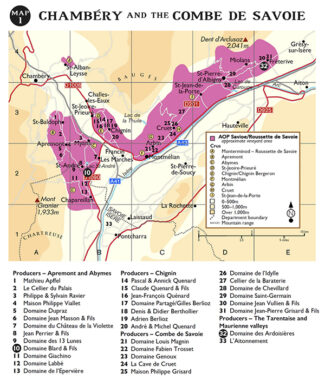
Jean-Noël and Thomas Blard are a father/son team who has taken their family domain to new quality heights while moving steadily toward fully organic and natural viticulture. In the 1990’s, Jean-Noël became one of the first vignerons in the appellation to diversify into Pinot Noir, and was also eager to raise the quality bar on Jacquère and Mondeuse—the latter by aging in neutral oak for a minimum of two years. With 25 acres under Blard control, grassed over and fertilized naturally, the Blards use a technique known as ‘intercep’ to remove unwanted greenery before finishing the job by hand.
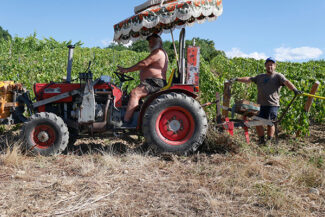
Jean-Noël and Thomas Blard, Domaine Blard & Fils
Five generations of Blard have snatched victory from the jaws of defeat: In 1248, the side of Mont Granier (one of the major formations of the Savoie’s Chartreuse Massif) collapsed, and a wave of boulders and scree crushed the landscape below, forever changing the soil structure. Apremont means ‘bitter mountain’ and Abymes means ‘ruin’ and as a result of the natural upheaval, it is today it is considered to be the best place in the Savoie (and by extension, all of France) to grow Jacquère.
Altesse (White): Her Highness, A Balancing Act
Nowhere in the world does Altesse reign as regally as in Roussette de Savoie, an AOP which has adopted the grape’s nickname ‘Roussette’ as its own. Late to ripen, and turning pink near harvest, the variety produces small grapes with a tight-bunch structure. Its most significant success is as a stand-alone varietal (chiefly in Roussette de Savoie and Roussette du Bugey), but it is also permitted as a minor blending component in the Jacquère-predominant Vin de Savoie wines.
The most likely origin theory is that Altesse is indigenous to the southern shores of Lake Geneva since it shares a close genetic link to the western Swiss workhorse Chasselas. Altesse is perfectly suited to the mountainous terroir around the western Alps in Savoie, and retains a high level of acidity while developing characteristic flavors of bergamot, hazelnut and almond. Such characteristics make it ideal for the production of sparkling wines as well and, consequently, Altesse is included in the region’s Crémant de Savoie wines and the sparkling Seyssel wines. Still Altesse wine is sometimes aged in oak and can age in bottle for up to five years.
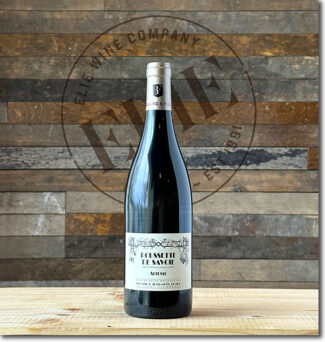 •1• Blard & Fils, 2020 Roussette de Savoie ‘Altesse’ ($31) 12.5% alc
•1• Blard & Fils, 2020 Roussette de Savoie ‘Altesse’ ($31) 12.5% alc
100% Altesse from Abymes, from vines that are 35 years old. As always, Thomas Blard ferments naturally, with 20% of the juice seeing skin contact for 10 days. Aged on the lees for 10 months before bottling, the wine presents a terrific nose of green grass, salt, lemon and ripe apricot. The palate follows with green tea, lime zest, and herbs behind an exhilarating, Chablis-like texture.
Jacquère (White): ‘Minerality’ Comes to Mind
Jacquère’s pedigree is 100% Français, and specifically Savoyard—at least, it’s impossible to find significant plantings outside the shadow of Mont Granier in the villages of Apremont and Abymes. The wines have characteristic cool-climate acidity vines and they write the book on the classic descriptors ‘mountain fresh’ and ‘alpine clean.’ Leaning toward the herbaceous with showers of freshly cut grass, green apples and pears, Jacquère is usually best when consumed young, while it still displays clean minerality and lively citrus palate.
It’s a high yielding vine, something that does not always lend itself to high quality. Since the 1980s, an attention to wine made from limited yields has resulted in wines with considerably more depth and weight, showcasing the region’s potential.
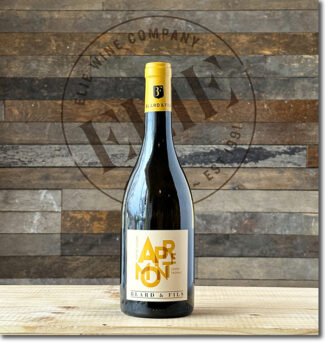 •2• Blard & Fils ‘Cuvée Thomas’, 2021 Vin de Savoie Apremont ($29) 11.5% alc
•2• Blard & Fils ‘Cuvée Thomas’, 2021 Vin de Savoie Apremont ($29) 11.5% alc
Cuvée Thomas is a blend of several different Jacquère parcels where vines are between 36 and 120 years old. Grown on clay/limestone soils seasoned with blue silex, the grapes are fermented on native years and aged ‘sur lie’ for nine months prior to bottling. The wine shows a delicate fresh almond bouquet above a foundation of crisp apricot and peach, with a mineral-driven palate that expresses textbook Jacquère salinity.
Malvoisie (White): Old Texts Misnomer
Lesson one is offered by INAO, the organization that defines appellations in France: Malvoisie does not belong to the Malvasia family, which produces many forgettable wines throughout the Mediterranean, including Pinot Grigio. Instead, it is Frühroter, a cousin to Austria’s famous Grüner Veltliner. It resembles Pinot Gris on the vine, and since Malvoisie was not, until recently, approved for Savoie, many growers simply labeled their Malvoisie ‘Pinot Gris.’
The second lesson comes from Thomas Blard himself: “Our Malvoisie is the real deal; Frühroter Veltliner and never Pinot Grigio.”
Frühroter Veltliner wines tend to be somewhat herbaceous with light lemony characters and often a note of almonds. It is an early ripening grape susceptible to frost, which accounts for the prefix ‘früh’, which means ‘early’ in German.
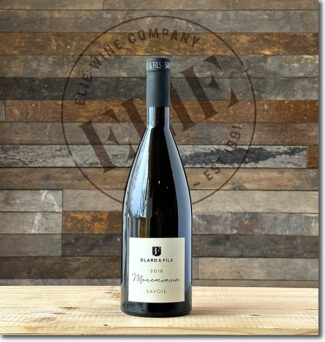 •3• Blard & Fils ‘Monemvasia’, 2019 Vin de Savoie ($37) 12.5%
•3• Blard & Fils ‘Monemvasia’, 2019 Vin de Savoie ($37) 12.5%
Thomas Blard does not make ‘Monemvasia’ every year; it is entirely dependent on the success of the harvest. Instead, in some years, Thomas and Jean-Noël do a sweet wine from the grape using ‘passerillage,’ the technique of drying the grapes in ambient air to concentrate sugars.
2019’s ‘Monemvasia’ is dry. It originates from 10-year-old vines from three different parcels with a mix of clay and limestone soils where elevations average 1200 feet. The wine, which shows delicate cucumber, Meyer lemon, and crisp mineral tones, was vinified in stainless steel tanks and aged 12 months in stainless and from Crémant.
Mondeuse Noire (Red): Savoie’s Most Historic Variety
Mondeuse Noire, commonly known simply as Mondeuse, is a grape with a distinctive personality. Having likely originated in eastern France, probably in or close to the region it now calls home, Savoie, it was once thought that Mondeuse was identical to the northern Italian grape Refosco as they both share similar botanical characteristics and flavor profile. DNA analysis has shown that they are separate varieties, while the same analysis revealed that Mondeuse is not a color mutation of Mondeuse Blanche, but is either its parent or offspring. The significance of this is that Mondeuse Blanche is one of the parents of Syrah, making Mondeuse Noire the grandfather of Syrah or half-brother to Syrah—something to keep in mind while tasting.
Like Syrah, Mondeuse offers violets, candied red fruit, dark berries, black pepper and spice enveloped in raspberry, blueberry, blackberry and plum with a bitter cherry and peppery finish.
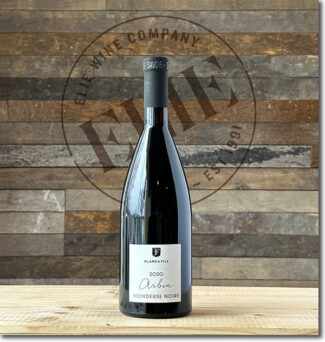 •4• Blard & Fils, 2020 Vin de Savoie Arbin ‘Mondeuse Noire’ ($39) 12% alc
•4• Blard & Fils, 2020 Vin de Savoie Arbin ‘Mondeuse Noire’ ($39) 12% alc
The Blard winery is actually in the Apremont region of France but they are leasing some 50-year-old Mondeuse vines in Arbin. Grown in clay and limestone soils, there is a pronounced iron-rich mineral note to the nose, along with red fruit and a little green apple carrying through. Somewhat lacy on the palate but with grip.
Pinot Noir (Red): Ripens Well On Steep Slopes, Occasionally Gamey
Though it makes up less than 7% of total Bugey plantings, Bugey is still the spiritual home for Burgundy’s red wine standby, and is the only legally allowable grape in red Bugey Cru Manicle. Manicle whites, like Burgundy, are made from Chardonnay. Manicle’s zone covers a small, south facing mountain slope on the southern apex of the Jura mountain range—a unique aspect that means it can be seen for miles to the south. The calcareous slopes of these southern extremities of the Jura Mountains offer an excellent environment for grape growing. This combines with the sunny aspect and good natural drainage of the landscape. The steep slopes of the Manicle Cru vineyards optimize sunshine exposure during the growing season. High altitude Pinot Noir sports fresh red fruit and seductive tannins; featured flavors are rose, raspberry, sour cherry, anise and paprika.
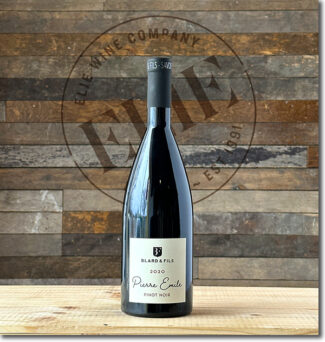 •5• Blard & Fils ‘Pierre Emile’, 2020 Savoie ‘Pinot Noir’ ($37) 12.5% alc
•5• Blard & Fils ‘Pierre Emile’, 2020 Savoie ‘Pinot Noir’ ($37) 12.5% alc
Considered by critics to be among the best examples of this varietal in Savoie, the wine shows gaminess behind its elegant cranberry mantle with hints of iron, forest floor, cassis, wild strawberry and violet. The acidity remains at the forefront and will be tamed with a bit more bottle time; the tans are elegant, silky and integrated.
The Rest …
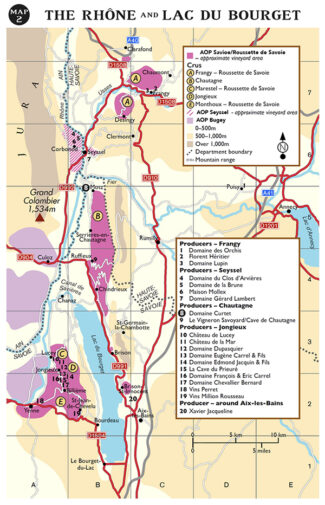
Domaine Marie & Florian Curtet
(Chautagne)
Chautagne is a sub-region of Vin de Savoie; to, qualify under the AOP name, the grapes must be grown either in Chautagne itself or in the neighboring communes of Motz, Ruffieux or Chindrieux. The appellation’s continental climate is tempered by the presence of Lac du Bourget (France’s deepest, largest lake) to the south, keeping the vineyards cooler in summer and warmer in winter. This effect is exacerbated by the high limestone cliffs which surround the valley, storing warmth and thus aiding the ripening process. As a result, the vineyards of Chautagne are often among the first to be harvested in Savoie, usually in early September.
After working for four productive years with Jacques Maillet, Florian Curtet took over Maillet estate in 2017, christening the new venture Domaine Curtet. It is comprised of the same 12-acre property on the hillsides above the Upper Rhône River near Switzerland. The holdings are highlighted by two distinct vineyard sites; Chautagne’s traditional grape varieties Gamay and Pinot Noir are planted in the commune of Serrieres en Chautagne in the lieu-dit ‘Vignes du Signeur’, the ‘Vines of the Lord’, while nearby, in the village of Motz, the traditional Savoie grapes Mondeuse, Jacquère, and Altesse grow in the vineyard known locally as ‘Cellier des Pauvres’, the ‘Cellar of the Poor.’
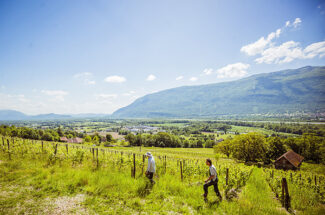
Marie and Florian Curtet, Domaine Curtet
Florian and his wife Marie farm biodynamically, adopting the spirit of ‘autrement’—an approach that is devoutly non-interventionist. The couple’s gregariousness and creativity is established in every facet of their process, symbolized by the dragonfly on their label to indicate the touch of nature showcased in every bottle.
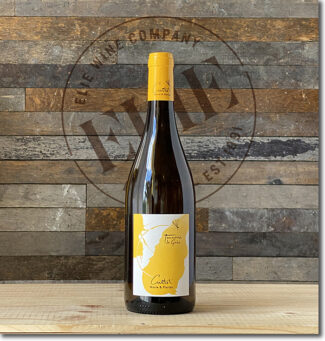 Domaine Marie & Florian Curtet ‘Tonnerre de Grès’, 2019 Savoie Blanc Natural ($46) 11% alc
Domaine Marie & Florian Curtet ‘Tonnerre de Grès’, 2019 Savoie Blanc Natural ($46) 11% alc
50% Jacquère, 50% Altesse from vines averaging 28 years in age and planted in Mollassic limestone soils with a west/southwest exposure. The grapes are first pressed, then fermentation/aging is done in concrete tanks over nine months on the lees. The wine’s aromatics are subtle and lovely—tart yellow apple and pear with a bit of almond flour, lavender and flint on the finish.
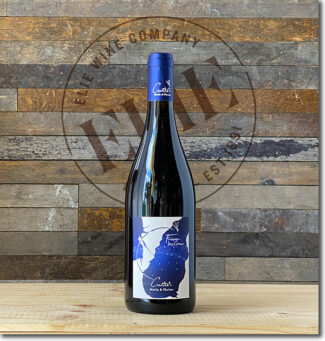 Domaine Marie & Florian Curtet ‘Frisson des Cimes’, 2019 Savoie Rouge ‘blue label’ ($46) 11% alc
Domaine Marie & Florian Curtet ‘Frisson des Cimes’, 2019 Savoie Rouge ‘blue label’ ($46) 11% alc
A blend of Gamay, Mondeuse and Pinot Noir from Motz, grown at elevations average one thousand feet with a southwest exposure. The soils here are the famed ‘molasse’ of the region, composed of shale and conglomerate that form as shallow marine deposits before rising mountain chains. The wine presents well, floral on the nose with subtle and high-toned aromas of blackberry, cassis and dark cherry with hints of white pepper adding a nice, spicy background.
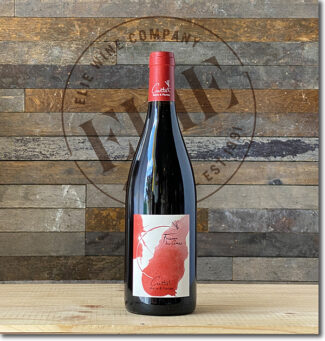 Domaine Marie & Florian Curtet ‘Frisson des Cimes’, 2018 Savoie Rouge ‘red label’ ($46) 10% alc
Domaine Marie & Florian Curtet ‘Frisson des Cimes’, 2018 Savoie Rouge ‘red label’ ($46) 10% alc
100% Mondeuse from 50 year old vines planted to sandstone with a western to southwestern exposure. In the cellar, whole-cluster fermentation is employed without pump-overs or push downs, a period that lasts 4-5 weeks before pressing. The wine is then aged in concrete tanks for 11 weeks, filtered lightly, and bottled with just a small dose of SO2. The wine shows mulched forest floor and sweet barnyard smells that lead to black plum, blueberries, pine and finishes with crunchy graphite.
Setting The (Country Wine IGP) Scene: Vin des Allobroges
IGP (Indication Géographique Protégée) is the Europe-wide name the category once called Vin de Pays, the ‘country wines’ of old. Certain wines from parts of the Savoie and Haute-Savoie region are not entitled to be labeled under the AOP name even if they hail from the same boundaries as Vin de Savoie, Roussette de Savoie or Seyssel. This category focuses on geographical origin rather than style and tradition, and gives winemakers greater stylistic freedom than AOP rules.
Domaine des Ardoisières
(The Tarentaise Valley)
Tarentaise vineyards pride themselves as being the first ones in France (if you’re coming from Italy); they sit slightly north of the 45th parallel and occupy the south-facing slopes of the Tarentaise Valley, where soils are composed of schist and ardoise. The area is on the comeback trail, reflecting a self-sufficient agricultural society that started to decline around 60 years ago, leaving behind much fallow land. From the 5000 or so vineyard acres that dotted the area during the first half of the 20th century, not many remain today, and those that do are maintained by a small number of diehard wine growers.
In 2005, Brice Ormont left the rolling hills of his native Champagne to make wine in the shadow of Mont Blanc. Domaine des Ardoisières was created in 1998 by the iconic grower Michel Grisard; Brice Ormont took over upon Grisard’s retirement. The vineyard was planted on slopes up to 60% in grade with local grape varieties like Jacquère, Mondeuse, Altesse, and Persan. So steep is the region that Ormont claims that it receives two hours less sunlight per day; an hour in the morning and another in the evening.
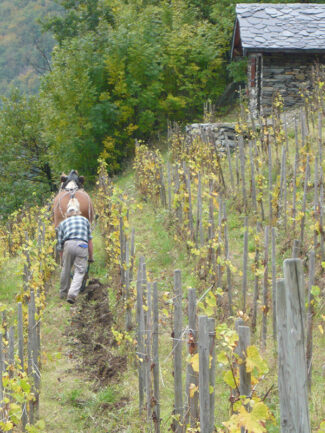
Brice Omont, Domaine des Ardoisières
Mondeuse Blanche (White): Rebirth in Allobroges
Despite the similarity in their names, Mondeuse Blanche is only a very distant cousin to Mondeuse Noire. In modern times, it has become nearly extinct and can be found only in a few acres in Savoie. It produces light, soft and floral wine, often blended with other grape varieties.
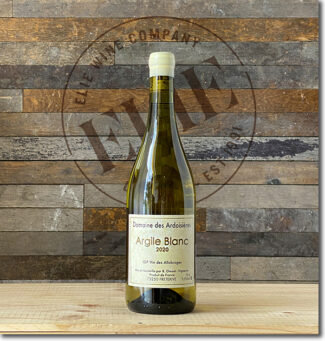 Domaine des Ardoisières ‘Argile’, 2020 IGP Vin des Allobroges ‘St-Pierre de Soucy’ Blanc ($36) 11.5% alc
Domaine des Ardoisières ‘Argile’, 2020 IGP Vin des Allobroges ‘St-Pierre de Soucy’ Blanc ($36) 11.5% alc
A blend of Chardonnay (40%) and Jacquère (40%) and Mondeuse Blanche (20%). Jacquère is a clean, high-acid alpine variety while Mondeuse Blanche, nearing extinction, is found in a small foothold in the Bugey sub-region halfway between Annecy and Lyon. Vines are planted to a mix of shale marl, hard black shale, and clay soil and the wine ferments in a mix of stainless-steel tanks and French oak barriques, then aged in used barrels for about eight months before bottling. The wine shows beautiful weight and tension, with smoke on the nose, ripe citrus on the palate, and salinity on the finish.
Gamay Noir à Jus Blanc (Red): Mellifluous When Young, Profoundly Delicious with Age
Gamay is grown throughout Savoie and Bugey—it is the most widely planted red variety in the region, covering about 14% of the AOP vineyards. As an early budding grape, it presents yearly challenges to an alpine climate, however, and the success of the harvest in any given season depends not only on the weather, but on the age of the vines and the skill of the producer. It is a favored red in Chautagne, in whose terroir it expresses a profile of cinnamon, spices, raspberry, strawberry and pepper.
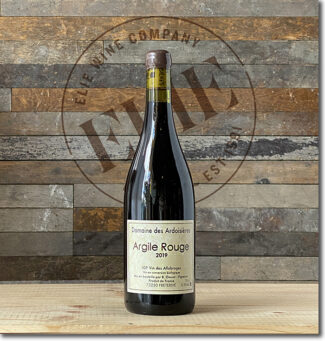 Domaine des Ardoisières ‘Argile’, 2019 IGP Vin des Allobroges ‘St-Pierre de Soucy’ Rouge ($45) 11% alc
Domaine des Ardoisières ‘Argile’, 2019 IGP Vin des Allobroges ‘St-Pierre de Soucy’ Rouge ($45) 11% alc
A blend of 80% Gamay and 20% Persan from 40-year-old vines grown on slate in Saint-Pierre-de-Soucy, ‘Argile Rouge’ is the rare wine that manages to present both delicacy and saturation at the same time. The nose is slightly smoky, with a touch of white pepper and red bramble; the fruit notes become more pronounced on the palate, which is bright with red currant and pomegranate. The true minerality of the mountain terroir shows up at the finish.
Persan (Red): A Deserved Renaissance
Persan is the poster-child grape for a wonderful variety that fell out of favor with growers, due in part to its susceptibility to fungal disease in damp weather. Among those in the know, who are willing to work with this fault, it is highly prized. Persan seems to have originated in the Maurienne Valley and was presumed extinct until it was rediscovered being grown by some local Savoie viticulturists who use it primarily as a blending grape. Alone, it produces age-worthy reds with a strong aromatic profile and in assemblages, this is what it brings to the table.
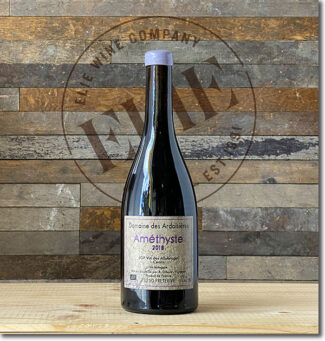 Domaine des Ardoisières ‘Améthyste’, 2018 IGP Vin des Allobroges ‘Cevins’ ($99) 11% alc
Domaine des Ardoisières ‘Améthyste’, 2018 IGP Vin des Allobroges ‘Cevins’ ($99) 11% alc
Biodynamically-grown Persan (60%) and Mondeuse Noire (40%) from the steep monopole Cevins with full southern exposure and a terroir of schist and mica. Yields are restricted to an average of only 20hl/ha, following which the grapes were whole-bunch fermented on native yeasts before spending 18 months in neutral oak. The flavor profile may be likened to a Côte-Rôtie with some of heavy notes replaced by the airy freshness of mountain wine; stone, raspberry and a touch of pepper to balance the bright salinity of the finish.
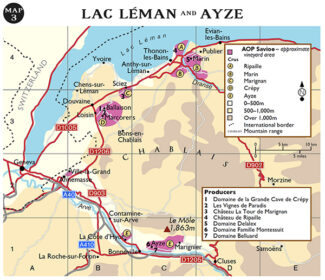
Notebook …
Climate Change: A Double-Edged Sword
“There is nothing constant but change.” Heraclitus, 500 BCE
It’s not likely that the Greek philosopher had Savoie wine industry in mind when he made his prophetic statement, but even in his time, viticulture depended almost entirely on the weather. And even then (and in every vintage since), the climate has been subject to gradual shifts, some more dramatic than others. Thomas Jefferson, who lived during the Mini-Ice Age of the eighteenth century was unable to grow vinifera grapes in his famed Monticello vineyards. Today, they thrive there.
In Savoie, where the threat of freezing temperatures early in the season and harsh storms in the fall haunts every vintage, there are some obvious upsides to warmer springs, hotter, drier summers and more temperate falls across the region.
But it’s a double-edged sword, since along with the extra balm comes unpredictable hailstorms, and although spring frosts may lessen on the whole, those that do hit seem to redouble in intensity. It doesn’t take more than a couple of these before a vineyard cannot recover. This doesn’t even touch on the potential threat to the ski industry, one of Savoie’s biggest draws and a steady source for wine customers.
Winemakers in Savoie feel somewhat helpless in the face of the climate—a plight of the profession since the days of Heraclitus. Innovation, which has saved the day throughout history, will find a way. In Savoie, a new generation is focused on sustainability and it is a start, but the hard truth is that marginal appellations Like Savoie are having to adapt and modify systems and farming practices that have been in place for centuries.
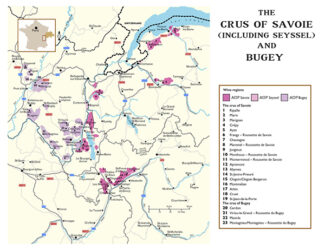
- - -
Posted on 2023.01.31 in Savoie, France, Wine-Aid Packages
Featured Wines
- Notebook: A’Boudt Town
- Saturday Sips Wines
- Saturday Sips Review Club
- The Champagne Society
- Wine-Aid Packages
Wine Regions
Grape Varieties
Aglianico, Albarino, Albarín Blanco, Albarín Tinto, Albillo, Aleatico, Arbanne, Aubun, Barbarossa, barbera, Beaune, Biancu Gentile, bourboulenc, Cabernet Franc, Cabernet Sauvignon, Caino, Caladoc, Calvi, Carcajolu-Neru, Carignan, Chablis, Chardonnay, Chasselas, Clairette, Corvina, Cot, Counoise, Erbamat, Ferrol, Fiano, Frappato, Friulano, Fromenteau, Fumin, Garnacha, Gewurztraminer, Godello, Graciano, Grenache, Grolleau, Groppello, Juan Garcia, Lambrusco, Loureira, Macabeo, Macabou, Malvasia, Malvasia Nera, Marsanne, Marselan, Marzemino, Melon de Bourgogne, Merlot, Mondeuse, Montanaccia, Montepulciano, Morescola, Morescono, Moscatell, Muscadelle, Muscat, Natural, Nero d'Avola, Parellada, Patrimonio, Petit Meslier, Petit Verdot, Pineau d'Aunis, Pinot Auxerrois, Pinot Blanc, Pinot Gris, Pinot Meunier, Pinot Noir, Poulsard, Prieto Picudo, Rondinella, Rousanne, Roussanne, Sangiovese, Sauvignon Blanc, Savignin, Semillon, Souson, Sparkling, Sumoll, Sylvaner, Syrah, Tannat, Tempranillo, Trebbiano, Trebbiano Valtenesi, Treixadura, Trousseau, Ugni Blanc, vaccarèse, Verdicchio, Vermentino, Viognier, Viura, Xarel-loWines & Events by Date
- April 2024
- March 2024
- February 2024
- January 2024
- December 2023
- November 2023
- October 2023
- September 2023
- August 2023
- July 2023
- June 2023
- May 2023
- April 2023
- March 2023
- February 2023
- January 2023
- December 2022
- November 2022
- October 2022
- September 2022
- August 2022
- July 2022
- June 2022
- May 2022
- April 2022
- March 2022
- February 2022
- January 2022
- December 2021
- November 2021
- October 2021
- September 2021
- August 2021
- July 2021
- June 2021
- May 2021
- April 2021
- March 2021
- February 2021
- January 2021
- December 2020
- November 2020
- October 2020
- September 2020
- August 2020
- July 2020
- June 2020
- May 2020
- April 2020
- March 2020
- February 2020
- January 2020
- December 2019
- November 2019
- October 2019
- September 2019
- August 2019
- July 2019
- June 2019
- May 2019
- April 2019
- March 2019
- February 2019
- January 2019
- December 2018
- November 2018
- October 2018
- September 2018
- August 2018
- July 2018
- June 2018
- May 2018
- April 2018
- March 2018
- February 2018
- January 2018
- December 2017
- November 2017
- October 2017
- September 2017
- August 2017
- July 2017
- June 2017
- May 2017
- April 2017
- March 2017
- February 2017
- January 2017
- December 2016
- November 2016
- October 2016
- September 2016
- August 2016
- July 2016
- June 2016
- May 2016
- April 2016
- March 2016
- February 2016
- January 2016
- December 2015
- November 2015
- October 2015
- September 2015
- August 2015
- July 2015
- June 2015
- May 2015
- April 2015
- March 2015
- February 2015
- January 2015
- December 2014
- November 2014
- October 2014
- September 2014
- August 2014
- July 2014
- June 2014
- April 2014
- March 2014
- February 2014
- January 2014
- December 2013
- November 2013
- October 2013
- September 2013
- August 2013
- July 2013
- June 2013
- May 2013
- April 2013
- March 2013
- February 2013
- January 2013
- December 2012
- November 2012
- October 2012
- February 2004
Search



